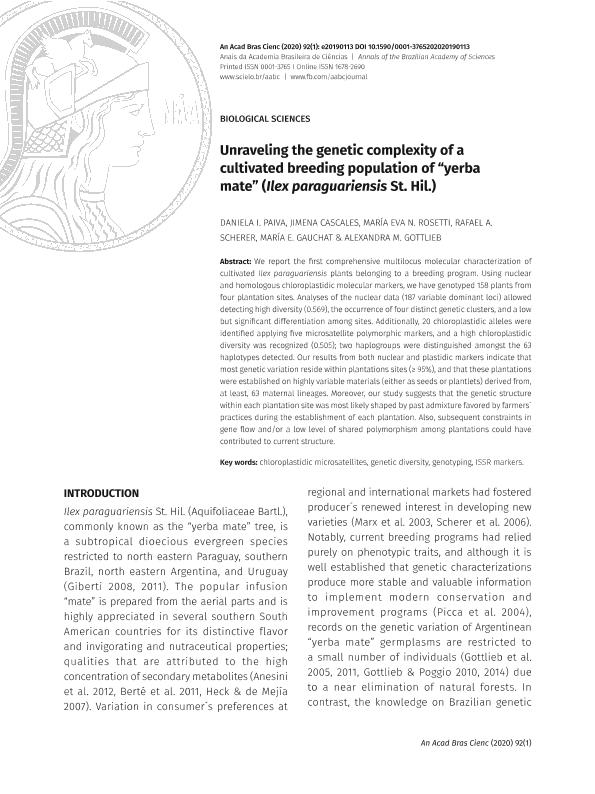Artículo
Unraveling the genetic complexity of a cultivated breeding population of "yerba mate" (Ilex paraguariensis St. Hil.)
Paiva, Daniela Ivana ; Cascales, Jimena
; Cascales, Jimena ; Rosetti, Maria Eva Natalia
; Rosetti, Maria Eva Natalia ; Scherer, Rafael Alejandro; Gauchat, María Elena; Gottlieb, Alexandra Marina
; Scherer, Rafael Alejandro; Gauchat, María Elena; Gottlieb, Alexandra Marina
 ; Cascales, Jimena
; Cascales, Jimena ; Rosetti, Maria Eva Natalia
; Rosetti, Maria Eva Natalia ; Scherer, Rafael Alejandro; Gauchat, María Elena; Gottlieb, Alexandra Marina
; Scherer, Rafael Alejandro; Gauchat, María Elena; Gottlieb, Alexandra Marina
Fecha de publicación:
04/2020
Editorial:
Academia Brasileira de Ciencias
Revista:
Anais da Academia Brasileira de Ciencias
ISSN:
0001-3765
e-ISSN:
1678-2690
Idioma:
Inglés
Tipo de recurso:
Artículo publicado
Clasificación temática:
Resumen
We report the first comprehensive multilocus molecular characterization of cultivated Ilex paraguariensis plants belonging to a breeding program. Using nuclear and homologous chloroplastidic molecular markers, we have genotyped 158 plants from four plantation sites. Analyses of the nuclear data (187 variable dominant loci) allowed detecting high diversity (0.569), the occurrence of four distinct genetic clusters, and a low but significant differentiation among sites. Additionally, 20 chloroplastidic alleles were identified applying five microsatellite polymorphic markers, and a high chloroplastidic diversity was recognized (0.505); two haplogroups were distinguished amongst the 63 haplotypes detected. Our results from both nuclear and plastidic markers indicate that most genetic variation reside within plantations sites (≥ 95%), and that these plantations were established on highly variable materials (either as seeds or plantlets) derived from, at least, 63 maternal lineages. Moreover, our study suggests that the genetic structure within each plantation site was most likely shaped by past admixture favored by farmers´ practices during the establishment of each plantation. Also, subsequent constraints in gene flow and/or a low level of shared polymorphism among plantations could have contributed to current structure.
Palabras clave:
CHLOROPLASTIDIC MICROSATELLITES
,
GENETIC DIVERSITY
,
GENOTYPING
,
ISSR MARKERS
Archivos asociados
Licencia
Identificadores
Colecciones
Articulos(IEGEBA)
Articulos de INSTITUTO DE ECOLOGIA, GENETICA Y EVOLUCION DE BS. AS
Articulos de INSTITUTO DE ECOLOGIA, GENETICA Y EVOLUCION DE BS. AS
Citación
Paiva, Daniela Ivana; Cascales, Jimena; Rosetti, Maria Eva Natalia; Scherer, Rafael Alejandro; Gauchat, María Elena; et al.; Unraveling the genetic complexity of a cultivated breeding population of "yerba mate" (Ilex paraguariensis St. Hil.); Academia Brasileira de Ciencias; Anais da Academia Brasileira de Ciencias; 92; 1; 4-2020; 1-17
Compartir
Altmétricas



